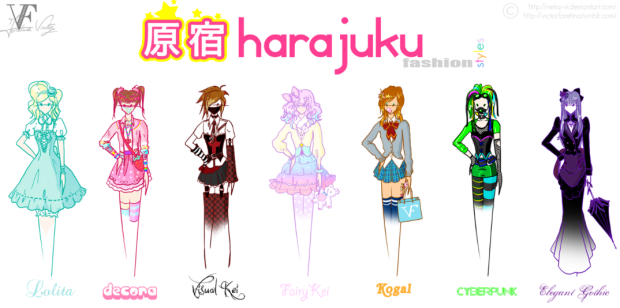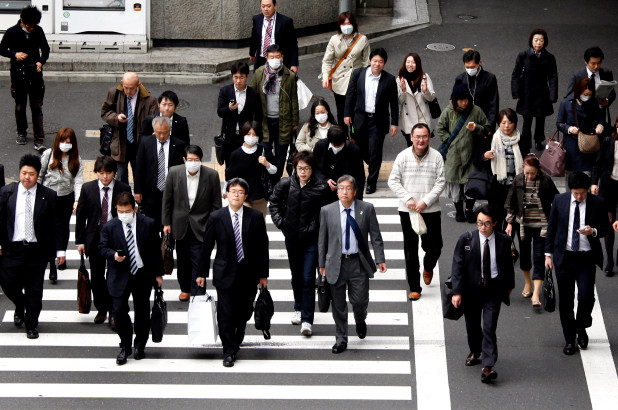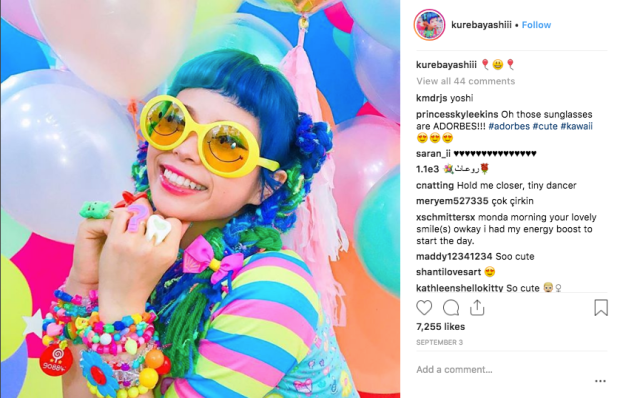Following on from my last blog post, I can happily announce that progress towards my Harajuku street fashion project is well underway. How well underway you may ask? Let’s just say that I’ve had very little trouble stumbling down the rabbit hole of this certain fashion scene.
At the start of this project, my initial plan of attack was to identify what Harajuku street fashion was. Among countless Google searches, YouTube binges, and even Pinterest boards, it eventually became apparent to me that Harajuku street fashion wasn’t just a single genre. Instead, I began to understand it as an umbrella term used to describe a range of subcultures that fit under fashion styles that have emerged in the district of Harajuku. Upon arriving at this, I began to feel a little hesitant towards my subject and even questioned my ability to proceed with this project. What is a subculture? Why are there so many of them? Do I have to research them all?!

Harajuku street fashion subcultures (source x)
Unlike many like myself who are quite content to throw on a t-shirt and jeans, Harajuku street fashion consists of layers. Not just physical layers, but conceptual layers. While researching this topic, I really didn’t consider Harajuku street fashion as more than just a trend. Upon further inspection, however, I’ve since started to interpret it more so as a form of art, as it often requires careful consideration and curation. From the choices that go into an individual’s clothing to their accessories, hair, make-up and everything in between, it became obvious that Harajuku street fashion didn’t just fit into one concise definition.
As a university student living in the west, I have often considered fashion as a form of expression. Something that lives through trends and is explored purely for aesthetic purposes. Contrastingly, Harajuku fashion serves a much deeper purpose. To represent a sense of identity or even to express certain statements that are both socially and politically charged. They are sometimes even aimed to challenge the conventional and conformist ways of the Japanese lifestyle.
“Rather than being treated as some strange, exotic enclave, the radical fashion of Harajuku is used for thinking about wider ideas relating to the possibilities (and limitations) of resistance through dressing.” (Groom,2011)
More interestingly, after watching short documentaries from the fashion and lifestyle YouTube channel, Refinery29, I began to understand the connotations and tags attributed to certain subcultures. I think what really struck me about these unique subcultures was the fact that they were able to emerge in such a conformist society like Japan. As Chang notes, ‘Japan is known as a conservative country especially for women. Most offices follow a strict dress code for the office environment and often requires their employees to wear uniforms”.

Japanese business attire – source (X)
Despite it’s polarity to traditional culture and western culture, I couldn’t help but find elements of certain subcultures quite familiar and relatable. I felt if there was anything I could relate this to, is perhaps its similarity to the grunge era in the 1990s, as fashion became a movement aimed to challenge societal norms and to project resistance.
Through autoethnographic research, I am hoping to draw on Ellis’ suggestion to “deepened my capacity to empathize with my subject”, as a way to understand just how and why certain cultures differ from my own (2011).
Although there are many avenues to explore in Harajuku street fashion, I thought that the best way to tackle my project was to primarily focus on a few particular subcultures. I decided this as a way to both alleviate the amount of research I’ll be doing, without compromising the quality. Of the subcultures, I decided to focus on include: Yami kawaii, fairy kei and decora.
As to why I chose these particular subcultures was purely based on the fact that they immediately caught my eye. I found their childish aesthetic quite amusing, especially as those who wear this particular style range from teenagers to adults. Another reason is that I don’t often encounter fashion choices like this in my real day-to-day life, so I thought embracing something new would be quite invigorating.

Famous decora girl, Kurebayashi (x)
In regards to how I am hoping to present my project, is that I will aim to produce an 8-minute vlog. I’ll be dividing this into three major chapters: first, my initial investigation and research (where my inspiration will stem from), second, the process of collecting harajuku fashion items, whether it be through physical retailers or online stores, and finally the transformation process (hair, make-up, and dress).
Why I chose the medium of the vlog is simply because I wanted to be able to narrate my own experiences in a thoughtful and visual way. I wanted to carry out my experience physically and verbally as told through elements of video and audio. As Ellis (2011) suggests, through autoethnographic practices such as this, narrating my personal experiences will allow me to provide rich insight into a phenomenon distinctly different from my own.
Once finished, I thought that the best way to bring my work together is to embed the video in a blog post. This will allow me to add further context to my subject. Pace (2012), considers reflexivity to be a strong element in understanding other cultures and states: “Autoethnographers reflexively explore their personal experiences and their interactions with others as a way of achieving wider cultural, political or social understanding”. Because of this, I am also hoping to include a brief reflection of my project to help consolidate my thoughts and understandings of Harajuku fashion.
References:
Ellis, C., Adams, T. and Bochner, A. (2011). Autoethnography: An Overview. [online] Qualitative-research.net. Available at: http://www.qualitative-research.net/index.php/fqs/article/view/1589/3095 [Accessed 9 Sep. 2018].
Groom, A. (2011). Power Play and Performance in Harajuku. [online] http://newvoices.org.au/newvoices/media/JPF-New-Voices-Vol-4-09-harajuku_groom.pdf [Accessed 9 Sep. 2018]
Pace, S. (2012). Using grounded theory analytic strategies in autoethnography. Writing the self into research, pp.1-15.
Header image: http://creativeindaba.com/blog/2017/08/16/harajuku-street-fashion/



Reblogged this on Digital Asia.
LikeLike
I think the idea of presenting this in a vlog is great because it just wouldn’t have the same effect as a normal blog. With my limited knowledge of this area it is already interesting to see what you have found out about Harajuku street fashion and how that has lead down a certain way. I think this is why autoethnographies are so useful because there are no barriers as to where the project has to go. I had a similar experience as your in terms on moving the project towards a more specific direction, feel free to check it out: https://ti371.wordpress.com/2018/09/19/autoethnography-methodology-explianed/
LikeLiked by 1 person
hi phi – i think it’s interesting how you’re taking an empathetic approach as outlined in the ellis reading, rather than one from a rigid research point of view. it fits quite nicely with your project, especially since you’re stepping out of your comfort zone and focusing the narrative on your personal experiences. i also think you’ve clearly outlined your own personal knowledge on fashion, both here and in japan. the analysis of your methodology makes sense with the research and experiences you plan to narrate, and it looks like your project is going to be intriguing.
i don’t usually recommend sources, but I can recommend youtuber ‘lovelylor’ who has a similar background to you – she is also a university student in the west, but she lives in the j-fashion lifestyle. good luck!
LikeLiked by 1 person
Hey Phi,
As someone who has very little knowledge on the Harajuku subculture overall I think it would be very beneficial and would love to see the actual process of your transformation, I think it would be a really engaging way to allow your viewers to understand the processes you have gone to in order to achieve the look!
I can remember watching a refinery 29 video on the ‘Decora’ fashion movement about a year ago which was really interesting, https://www.refinery29.com/japanese-decora definitely check it out if you’re interested.
Looking forward to seeing where this project takes you!
Emily 🙂
LikeLiked by 1 person
Hello Phi,
I’ve seen videos on Youtube about Harajuku street fashion, specifically the one you linked on this post. But my knowledge of the whole phenomenon itself is limited. I think it’s so significant as an autoethnographic approach, as you have mentioned by Ellis et al “empathize with my subject”. To emphasize with others or cultures that are different to us, enables us to not limit ourselves as an autoethnographer and to experience the Harajuku street phenomenon and empathise and understand it’s social and political agenda on a deeper and personal level. Therefore, I believe your ability to empathise and the whole of your autoethnographic process enables you to have a “meaningful, accessible, and evocative research grounded in personal experience” as outlined by Ellis et al.
Amazing work! I can’t wait to see what’s to come with your DA.
LikeLiked by 1 person
I definitely think you have one of the most interesting DA ideas this semester. I think you’ve done a really good job researching and communicating on Harajuku fashion, and I especially like how you’ve compared it to grunge as rebellion through fashion
Even when Harajuku styles don’t appeal to my personal sense of style, I can still appreciate them; except for Yami Kawaii. I vaguely knew about the style before hand (but didn’t know what it was called, and to me it feels almost like a commodification and celebration of serious mental illness and death, which makes me super uncomfortable. But I think your blog post has helped me better understand why someone would wear Yami Kawaii (even if it still makes me feel a bit icky)
I know there’s another type of fashion called “Guro Lolita”, which is like… gore lolita with fake blood and from what I’m seeing on Google Images seems to have a bit of a medical/hospital theme? That one might be more on the side of “costume” rather than “fashion” but I feel like it has some similarities with Yami Kawaii’s creepy-cute aesthetic, if you’re interested
LikeLiked by 1 person